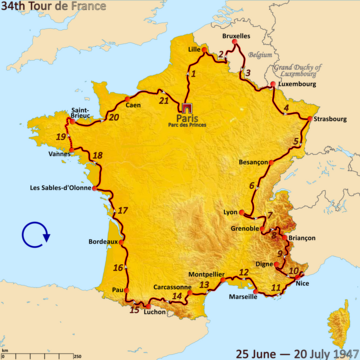 Route of the 1947 Tour de France followed clockwise, starting and finishing in Paris | |||||||||||||||||||||||||
| Race details | |||||||||||||||||||||||||
|---|---|---|---|---|---|---|---|---|---|---|---|---|---|---|---|---|---|---|---|---|---|---|---|---|---|
| Dates | 25 June – 20 July 1947 | ||||||||||||||||||||||||
| Stages | 21 | ||||||||||||||||||||||||
| Distance | 4,642 km (2,884 mi) | ||||||||||||||||||||||||
| Winning time | 148h 11' 25" | ||||||||||||||||||||||||
| Results | |||||||||||||||||||||||||
| |||||||||||||||||||||||||
The 1947 Tour de France was the 34th edition of the Tour de France, taking place from 25 June to 20 July. The total race distance was 21 stages over 4,642 km (2,884 mi). It was the first Tour since 1939, having been cancelled during World War II, although some Tour de France-like races had been held during World War II.
Because the previous races had been canceled, there was no real favourite for the final victory. When René Vietto, the runner-up of 1939, captured the yellow jersey after his victory on the second stage, many thought he could remain first until the last day. Vietto, a climber, was less optimistic and lost his first place to Italian Pierre Brambilla after the time trial in stage 19. With only two stages to go, many now believed that Brambilla would win the race. On the last stage, there was an unexpected attack, and little-known French cyclist Jean Robic captured the lead. Robic had won the Tour de France without ever wearing the yellow jersey during the race, the first time that happened. (In 1953 Robic would lead the race for one more day).